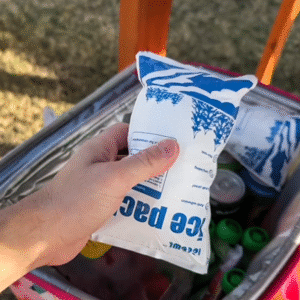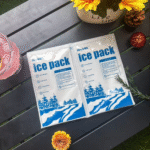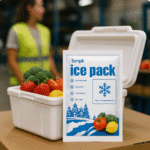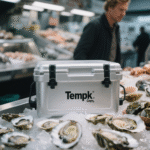If you need an Australia dry ice pack sheet hoje, this field guide shows you how to pick the right format, size it in minutes, and move it safely. You’ll learn a fast mass estimator, a loading pattern that protects goods from over‑freezing, e 2025 buying tips. Use the tools below to plan your route, cut waste, and keep temperature‑sensitive products stable from pickup to delivery.
-
Which formats of Australia dry ice pack sheet suit food, farmacêutico, and e‑commerce routes
-
How to calculate Australia dry ice pack sheet mass for your cooler or shipper
-
How to load an Australia dry ice pack sheet to prevent contact freezing
-
Onde Australia dry ice pack sheet beats gel packs—and where it doesn’t
-
O que mudou em 2025 para Australia dry ice pack sheet availability and safety practice
What is an Australia dry ice pack sheet and when should you use it?
Resposta direta
An Australia dry ice pack sheet is a flexible, perforated matrix filled with CO₂‑based cooling cells that behaves like a bendable “blanket” for rapid pull‑down and even coverage. Compared with rigid blocks, it wraps around goods for better contact; compared with loose pellets, it’s cleaner and easier to portion for small orders.
Explicação expandida
Think of the sheet like a quilt that emits deep cold. You trim or fold it to fit pouches, cartons, or cooler lids. Because a sheet distributes contact across a wider area, it cools faster than a single block at the same mass. For delicate produce or meds that must not freeze, you add a thin buffer (cardboard or towel) between the Australia dry ice pack sheet and product. Use sheets for last‑mile deliveries, sample returns, and multi‑stop routes where you want fast pull‑down with less mess than pellets.
Pellet bag, bloquear, or Australia dry ice pack sheet: which fits your route?
Detalhes
Pellets pour into voids and chill quickly, but they scatter. Blocks run longest, but contact is limited. Um Australia dry ice pack sheet bridges both: flexible like pellets, tidy like a block. For mixed totes, a sheet on top plus a divider below protects fragile foods and keeps everything stackable.
| Cooling Format | Melhor para | Typical Behavior | What It Means For You |
|---|---|---|---|
| Pellets (“rice”) | Quick pre‑chill, small gaps | Pull -redone rápido, Duração mais curta | Ideal for short drives and frequent lid opens |
| Solid block | Long hold time | Slower start, longest duration | Best for overnight or minimal access |
| Pack sheet | Even coverage, clean handling | Pull -redone rápido + tidy loading | Great for last‑mile and mixed loads |
Dicas e sugestões práticas
-
For mixed groceries: Place a thin cardboard layer under the Australia dry ice pack sheet to avoid contact freezing on leafy greens.
-
For clinical samples: Pre‑chill the shipper with a half‑sheet for 10 minutos, then load and add the main sheet.
-
For weekend trips: Cut one sheet into two panels; keep a spare panel wrapped for the return leg.
Caso real: A Sydney meal‑prep brand trimmed an Australia dry ice pack sheet to fit a 40‑quart cooler with a towel buffer. Entrees stayed frozen for a 7‑hour route with five door openings and zero frostbite on herbs.
How do you size an Australia dry ice pack sheet for your cooler or shipper?
Resposta direta
Start with 0.20–0.30 lb of sheet per quart of cooler volume for ~24 hours in mild weather, then adjust for heat and door‑open frequency. Add 25–50% mass for hot days or frequent access. Keep sheets on top so cold air sinks.
Explicação expandida
You’re fighting heat leak from ambient air and from opening the lid. The quick estimator below trades lab complexity for field reliability. It gets you close on the first run and lets you refine after a trip log. If your load is very delicate—like pastries or soft cheese—use a divider and spread the Australia dry ice pack sheet as a cap rather than a blanket.
Quick mass estimator for an Australia dry ice pack sheet
Detalhes
Use this simple rule, then tune for climate and access. For multi‑day holds, multiply by hours/24 and add a safety factor.
| Tamanho mais frio | Mild Weather (24h) | Hot Weather (24h) | Why It Helps |
|---|---|---|---|
| 35–45 qt | 7–11 lb of Australia dry ice pack sheet | 10–15 lb. | Matches typical family coolers |
| 50–60 qt | 10–15 lb. | 14–20 lb | Adds buffer for lid openings |
| 70–90 qt | 14–20 lb | 18–26 lb. | Supports bigger loads or longer runs |
Dicas e sugestões práticas
-
Tight packing: Fill voids so your Australia dry ice pack sheet cools product, not empty air.
-
Two‑stage cooling: Pre‑chill with a half‑sheet, then add the full sheet before departure.
-
Hybrid method: Cap with a sheet for speed, then add a small block for duration.
Caso real: A regional seafood courier used the formula for a 60‑quart cooler on a 30°C day with 3 opens/hr. The estimator suggested ~18 lb of Australia dry ice pack sheet; they loaded 16 lb plus a towel buffer and returned with firm fillets and dry packaging.
How do you load and handle an Australia dry ice pack sheet safely?
Resposta direta
Vent your container and vehicle, Use luvas isoladas, and avoid airtight seals. CO₂ is odorless and displaces oxygen; a small window gap and a vented lid keep you safe. Coloque o Australia dry ice pack sheet on top of a buffer so cold air sinks over the goods.
Explicação expandida
Treat the sheet like a slow‑release gas source. In cars and vans, keep fresh air moving. Never tape lids shut or pack sheets in sealed jars. For small apartments, let unused pieces sublimate outdoors or in a well‑ventilated shed away from children and pets. The same habits protect your cooler from pressure deformation and protect food from freeze damage.
Safety checklist for an Australia dry ice pack sheet
Detalhes
Follow these steps every time. They take seconds and control most risks without special gear.
| Etapa | What To Do | Simple Rule | Meaning For You |
|---|---|---|---|
| Ventilação | Crack windows 2–3 cm | Fresh air in, CO₂ out | Reduces drowsiness risk |
| Tampa ventilada | Leave a small latch gap | No airtight coolers | Avoids lid pop or warping |
| Hand protection | Use insulated gloves or a folded towel | No bare handling | Prevents cold burns |
| Buffer layer | Cardboard or towel over goods | Sem contato direto | Avoids freezer burn |
Dicas e sugestões práticas
-
In elevators or closets: Do not park a cooler emitting CO₂—choose open, airy spaces.
-
At drop‑off: Brief the receiver to vent and re‑cap the Australia dry ice pack sheet after opening.
-
For disposal: Place leftover sheet on a tray to sublimate; never flush or bin while active.
Caso real: A mobile lab driver used a vented foam shipper and a 3 mm lid gap while carrying an Australia dry ice pack sheet for four hours. The lid stayed stable and samples arrived within spec.
How does an Australia dry ice pack sheet compare to gel packs, PCM Bricks, and blocks?
Resposta direta
An Australia dry ice pack sheet delivers lower temperatures and faster pull‑down per kilogram than gel packs or PCM bricks, at the cost of venting needs and handling care. Blocks last longer per piece but lack even coverage. Choose sheets when you need clean handling, fast chill, and flexible placement.
Explicação expandida
Think of cooling like tools in a kit. The sheet is your “flexible power tool”: deep cold and tidy. Gel packs are your “safe wrench” for 0–8°C where freezing is risky. PCM bricks hold a narrow temperature but warm slowly. A hybrid—sheet for pull‑down plus gel packs for edge buffering—often gives the best result for chocolates, pastry, or vaccine kits labeled “do not freeze” at the surface.
Side‑by‑side comparison for common goals
Detalhes
Use this table to avoid overbuying and to pick the right partner for your Australia dry ice pack sheet.
| Meta | Best Option | Por que | Your Move |
|---|---|---|---|
| Congelamento rápido | Pack sheet or pellets | High surface contact | Cap with sheet; pre‑chill container |
| Long hold (>24h) | Block + folha | Duração + coverage | Add a small block under the sheet |
| Chilled only (2–8 ° C.) | Gel or PCM | Freeze‑safe | Use sheet only for quick pre‑cool (buffer) |
| Clean handling | Pack sheet | No scatter | Trim to fit, tape corners if needed |
Dicas e sugestões práticas
-
Chocolates: Use a thin divider plus a small Australia dry ice pack sheet on top for 60–90 minutes, then swap to gels.
-
Soft cheeses: Mantenha o Australia dry ice pack sheet above a buffer; evite contato direto.
-
Sorvete: Use a thicker sheet or add a block; open the lid as few times as possible.
Caso real: A boutique chocolatier reduced bloom by replacing pellets with an Australia dry ice pack sheet cap and a divider. Breakage dropped and box interiors stayed dry.
Which industries benefit most from an Australia dry ice pack sheet?
Resposta direta
E‑commerce food, frutos do mar, laboratórios, and event catering benefit most because the Australia dry ice pack sheet trims prep time, improves temperature pull‑down, and stays tidy during multi‑stop routes. It also scales—from a single panel in a mailer to full‑sheet caps for large coolers.
Explicação expandida
If you batch orders, you can pre‑cut sheets during staging. If you run returns (por exemplo, clinical swabs), a small panel taped inside the lid speeds chill without loose pellets. If you must show clients a clean presentation (weddings, tastings), sheets keep cartons clean.
Sector‑specific notes for your SOP
Detalhes
Use these starts to write or update your standard operating procedures.
| Setor | Load Type | Sheet Placement | Por que funciona |
|---|---|---|---|
| Meal‑prep | Entrées with greens | Sheet cap + divider | Pull‑down + no contact freeze |
| Frutos do mar | Fillets and shellfish | Half‑sheet cap + bloquear | Velocidade + duration combo |
| Labs | Return kits | Quarter‑sheet in lid | Rápido, limpar, small footprint |
| Eventos | Pastries & chocolate | Buffered sheet cap | Tidy, photogenic packouts |
Dicas e sugestões práticas
-
SOP template: Define panel sizes (¼, ½, full) for each SKU.
-
Route logs: Track sheet weight vs. ambient and hold time; tune weekly.
-
Treinamento: Teach “cap, buffer, vent” as a three‑word safety mantra.
Caso real: A Brisbane caterer standardized on half‑sheets for cold desserts. Setup time fell by 20 minutes per event and returns for texture issues nearly disappeared.
How can you plan inventory for Australia dry ice pack sheet across seasons?
Resposta direta
Forecast demand using a simple heat‑index multiplier and event calendar, then buffer 15–25% for heat waves and holidays. Keep two formats on hand: half‑sheets for day routes and full sheets for overnight or bulk orders.
Explicação expandida
Dry ice usage climbs with ambient temperature and customer volume. A small buffer saves costly second trips. Because Australia dry ice pack sheet is modular, you can trim to size and avoid waste on cool days. Rotate first‑in, first‑out to keep packs fresh and packaging crisp.
Inventory quick‑planner for Australia dry ice pack sheet
Detalhes
Use last month’s consumption, then adjust for forecast conditions.
| Month Type | Season Factor | Example Adders | Por que isso importa |
|---|---|---|---|
| Leve | 1.0 | No events | Baseline stock |
| Esquentar | 1.2 | Weekend festivals | More mass for longer runs |
| Quente | 1.4 | Holidays & promos | Avoids stockouts and rush fees |
Dicas e sugestões práticas
-
Morning pickups: Heat loads are lower; Australia dry ice pack sheet lasts longer.
-
Two‑bin system: One bin for pre‑cut panels, one for full sheets.
-
Rotulagem: Mark panel mass after trimming to aid operators.
Caso real: A Gold Coast grocer tracked daily usage and moved to a two‑bin system. Waste dropped by ~12% in summer compared to ad‑hoc trimming.
2025 trends for Australia dry ice pack sheet: what’s new?
Visão geral da tendência
Em 2025, retailers expanded point‑of‑sale guidance for Australia dry ice pack sheet, and cooler makers pushed vented‑lid designs for safer transport. More suppliers pre‑score sheets for easy trimming, and route operators widely adopted “cap + buffer + vent” as a standard practice for mixed SKUs.
Últimos desenvolvimentos de vista
-
Pre‑scored grids: Easier one‑hand trimming and less product exposure time.
-
Vented hardware: Hinges and latches that hold a safe gap while driving.
-
Hybrid playbooks: Combining a small block with an Australia dry ice pack sheet cap to balance speed and duration.
Insights de mercado
Demand spikes during heat waves and event seasons in major cities; shoulder months see steadier supply. Customers prefer clean, pre‑bagged options and quick curbside pickup. Logging cooler size, tempo de rota, ambiente, and sheet mass is becoming standard to right‑size orders and reduce re‑routes.
Perguntas frequentes
Q1: How long will an Australia dry ice pack sheet last in a 45‑quart cooler?
About a full day with 8–10 lb in mild weather; longer with a small block and fewer lid opens. Pre‑chill and use a buffer to protect sensitive items.
Q2: Can I use an Australia dry ice pack sheet for medications labeled “do not freeze”?
Use with caution. If the label forbids freezing, rely on gel packs for 2–8°C and use the sheet only to pre‑cool the container with a divider, then remove.
Q3: Is it safe to transport an Australia dry ice pack sheet in a car trunk?
Avoid sealed spaces. Keep the cooler in a ventilated cabin with a slight window gap or use a pass‑through. Always leave a lid vent.
Q4: Should I choose a sheet or a block for overnight trips?
Use both: a small block for duration plus an Australia dry ice pack sheet cap for fast pull‑down and even coverage.
Q5: How do I prevent freezer burn on produce with an Australia dry ice pack sheet?
Add a cardboard or towel divider. Keep the sheet on top so cold air sinks over, not into, delicate surfaces.
Q6: What’s the best way to dispose of leftovers from an Australia dry ice pack sheet?
Let it sublimate on a tray in a ventilated, secure area—never in sinks or sealed bins.
Q7: Can I trim an Australia dry ice pack sheet to fit small mailers?
Sim. Use scissors along pre‑scored lines. Mark the remaining panel mass for your next job.
Resumo e recomendações
Pontos -chave
Use um Australia dry ice pack sheet when you need flexible placement, fast pull‑down, and clean handling. Size by cooler volume, calor ambiente, e aberturas de tampa. Cap, buffer, and vent—every time. Combine with a small block for long runs, or hand off to gels for chilled‑only targets.
Plano de ação
-
Pick your format (sheet for speed/coverage, block for duration). 2) Use the estimator to set a starting mass. 3) Carregar produto, add a buffer, place the Australia dry ice pack sheet no topo, e desabafar a tampa. 4) Log route time, ambiente, and remaining mass to refine. Need a tailored plan? Contact Tempk for a five‑minute sizing consult.
Sobre Tempk
We are a cold‑chain solutions team focused on practical results. We help operators choose and use an Australia dry ice pack sheet efficiently with simple estimators, clean loading patterns, and safety checklists. Our two advantages: rápido, field‑tested heuristics you can apply on the dock, and packaging setups that reduce waste without risking product quality.
Chamado à ação: Speak with Tempk for a quick sizing review or an SOP tune‑up for your routes.
























